
|
ADINA FEA offers a wide range of nonlinear material models such as concrete, steel and soil models which can be effectively used for modelling steel and concrete structures and their surroundings. The effect of steel reinforcement in concrete can be taken into account by embedding the reinforcement inside the continuum elements.
Staged construction is an important aspect in many civil engineering applications such as in excavation, tunnelling, and the seismic retrofit of structures. The element birth/death capability in ADINA FEA offers an easy way for modelling such problems.
Aging infrastructure has increased the need for in-depth analyses of existing structures, both for replacement and retrofit. Using a comprehensive and reliable analysis tool is the key factor in understanding the behaviour of existing structures and in developing the best retrofit procedures and designs. |
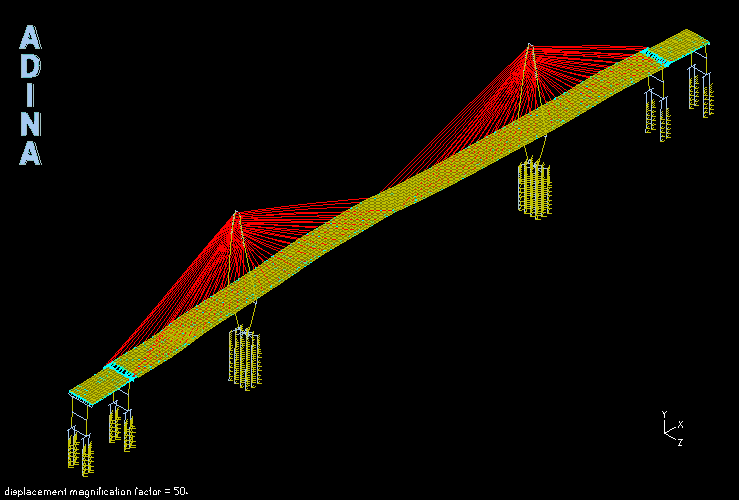

|
Tel: +44 (0)121 703 9236 or e-mail: info@pdslimited.com © Copyright Product Development Services Ltd. All rights reserved 2012 |
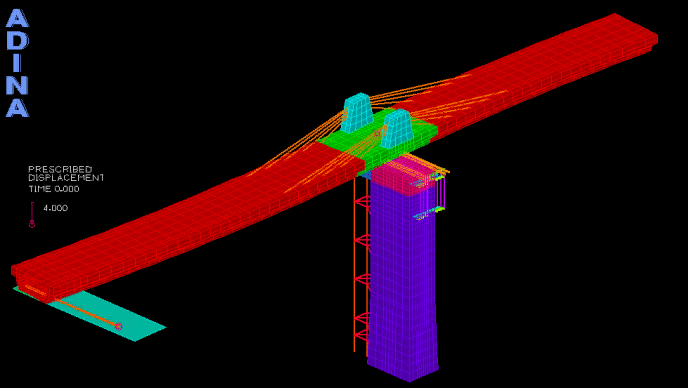
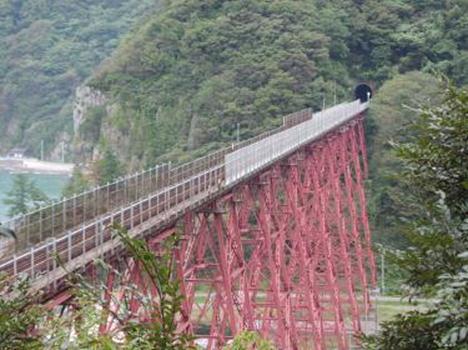
|
The span length of this bridge is about 1,005 m and is currently the largest cable-stayed span in North America. The two diamond shaped towers (of height about 175-m) support a deck carrying 8 traffic lanes and a pedestrian walkway/bikeway. The main span utilizes a composite concrete deck with I-shaped steel edge girders.
Design checks of the seismic performance of the bridge were made, including the inelastic time history analysis of the main span unit and the West and East high level approach structures combined in a single model.
The model was subjected to spatially varying ground motion time histories. All towers and piles were modelled using ADINA moment-curvature beam elements; soil-structure interaction was modelled explicitly with plasticity-based truss elements; and pushover analyses of the stand-alone tower/foundation models were conducted to validate the characterizations of the physical behaviours.
The animation shows the central part of the bridge under seismic loading (with the movements magnified 50 times). Such nonlinear simulations of course not only require the use of a powerful and reliable analysis tool. |
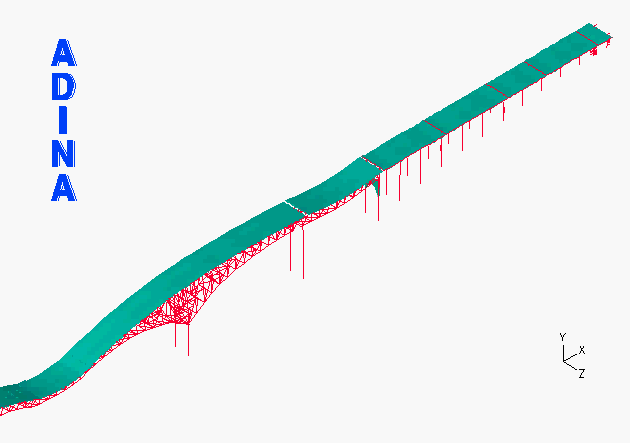
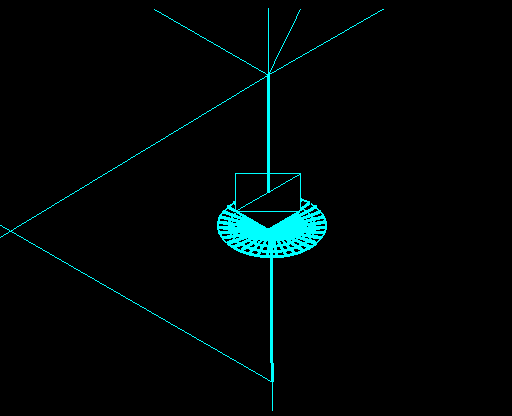
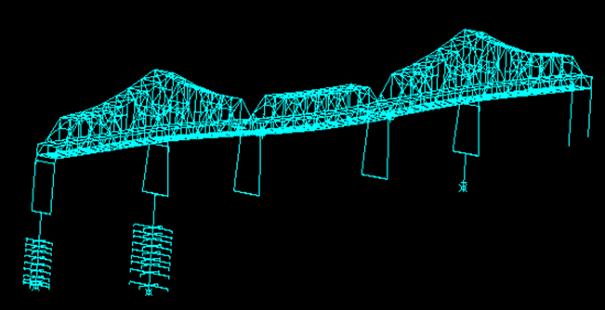
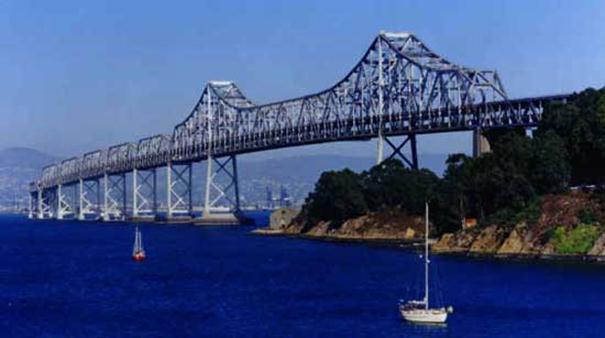
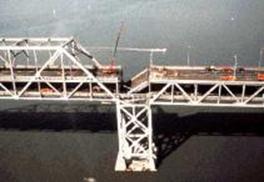
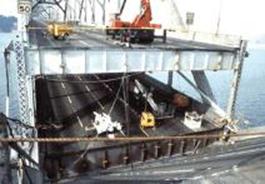
|
In response to the extensive damage caused by the 1989 Loma Prieta earthquake, the California Department of Transportation (Caltrans) commissioned a seismic-retrofit project for six of the major toll bridges in California, including the famous San Francisco Oakland Bay Bridge.
ADINA was selected (for its reliability) to be used for the seismic analysis of these bridges to determine what retrofitting or new sections of bridges should be constructed.
ADINA was used for both the linear and highly nonlinear analyses (including large displacements, plasticity, and contact) of the six major toll bridges in California after the 1989 Loma Prieta earthquake.
Here, the model of a section of the old Bay Bridge subjected to an earthquake load is shown. Subsequent to this analysis, ADINA was used by the California Department of Transportation and its contractors to design a brand new bridge section spanning from Oakland to Treasure Island.
A photograph of a section of the damaged bridge with a close-up view is shown below. |
|
ADINA is widely used in the construction industry all around the globe.
The Amarube Railway Bridge, one of the Japanese legacy steel bridges, was replaced by a new prestressed concrete bridge in 2010.
In the replacement process (conducted by Shimizu Corporation), a prestressed concrete girder of 93-meter length and 3820-ton weight was moved with slow sliding on the support structures to be adjusted to the tunnel entrance (see picture below left).
The sliding process consisted of 2 stages; in stage 1, the girder was subjected to 4-meter sliding in the normal direction to the railway axis, and in stage 2, it was subjected to a 5-degree rotational sliding about the axis of the bridge column (see movie above). |

|
In modern earthquake engineering, design for seismic isolation has become increasingly important for the prevention of devastating damage in a major earthquake. One effective and practical method for seismic isolation is the use of friction pendulum bearings, of which many may be used in a bridge structure. In this example we see the modelling and use of friction pendulum bearings for the seismic isolation of the Aurora Bridge that spans Lake Union in Seattle, Washington. A typical location of these frictional bearings is marked in the figure below |
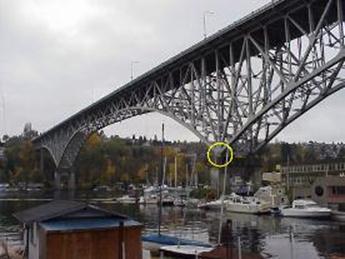
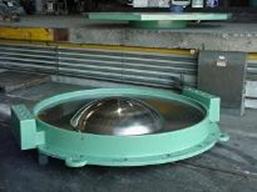
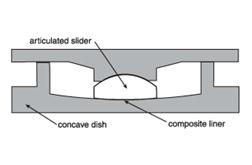
|
The pictures on the far left show a friction pendulum bearing consists of a stainless steel concave dish and a stainless steel articulated slider surfaced with a composite liner. During an earthquake the slider moves back and forth on the concave dish; the spherical surfaces of the slider and the dish define a motion similar to that of a pendulum. The bearing isolates a structure from an earthquake through pendulum motion, and absorbs earthquake energy through friction.
Using contact surfaces with friction, a friction pendulum bearing model is implemented in ADINA as shown on the left. The dish is modelled with a spherical rigid contact surface. The slider is modelled with just two tetrahedral elements. The opposing contact surfaces (slider and dish) are defined as a contact pair with a coefficient of friction equal to that specified for the bearing.
The movie at the top shows the overall (magnified) response of the Aurora Bridge under seismic loading. The movie on the left shows the response of one of the friction pendulum bearings under the same seismic loading. |
|
Courtesy of T.Y. Lin International |



|
Seismic Evaluation of the Cooper River Bridge |
|
INDUSTRIES |
|
|
Amarube Railway Bridge (Japan) Retrofit Project |
|
Courtesy SC Solutions, Inc. |
|
Seismic Isolation of the Aurora Bridge |
|
Seismic analysis of San Francisco Oakland Bay Bridge |
|
The ADINA finite element model is shown below. All of the concrete members were modelled using 3D solid elements, the steel members were modelled using beam elements, and the tow cables were modelled using truss elements. Frictional contact conditions were considered on the bottom surface of the bridge girder and on the top surfaces of the columns |
|
Courtesy of Shimizu Corporation (through Kozo Keikaku Engineering) |